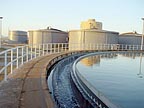
“Protection of America's drinking water systems is a critical element of EPA's mission. The agreements we are recognizing here are outstanding examples of how government and industry are working together to find ways to protect our water from contamination,” says EPA's Steve Johnson. “We are excited about the prospect that these partnerships will help water utilities implement effective, new early warning systems for drinking water contamination.”
The water quality sensor technologies and software in these research agreements potentially may be incorporated into an early warning system that will provide local water quality officials with a real time alert of intentional or accidental drinking water contamination. The water quality sensors would respond to the presence of a contaminant in drinking water, and produce readings that can be interpreted by the software, together forming an early warning system. Earlier detection of contamination can allow water quality officials to more effectively isolate and contain a problem before it migrates through the water distribution system.
Under the Federal Technology Transfer Act, this type of Cooperative Research and Development Agreement or CRADA, allows private industry and state/local governments access to federal laboratories to exchange EPA personnel, equipment or services for a particular project. The goal of this effort is to more efficiently collaborate to move technology into real world applications.
ND
Report Abusive Comment